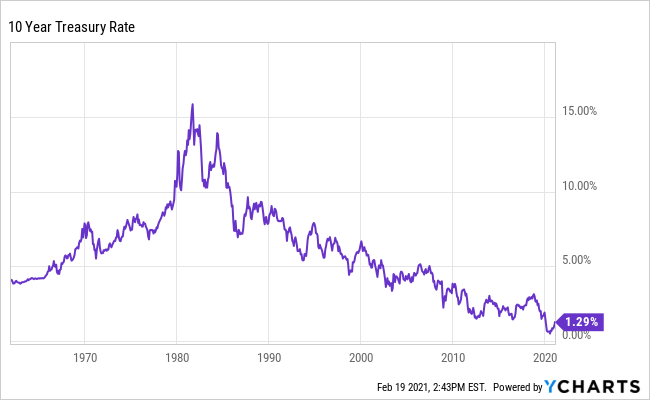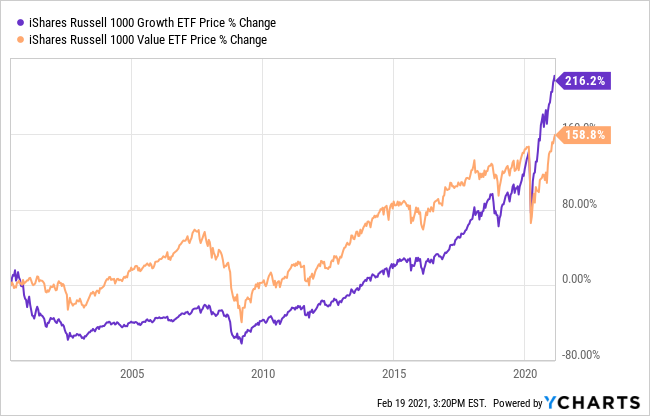Summary
- Interest rates remain at unprecedented low levels.
- Today, most "typical" fixed income and bond related investments provide very tiny returns for investors and retirees.
- As a result, investors are set to "migrate" into dividend stocks.
- High dividend stocks have underperformed in the past two years and present a great buying opportunity.
- Now is the time to "load up" on dividends!
Incredibly Low Rates
Interest rates have fallen to levels never seen before in America in recorded financial history. We’ve seen short-term rate on Treasury bills get to similar levels, but the 10-year rate has hit levels never seen before. Through numerous global events like the Great Depression, the 10-year rate never got this low. In the wake of 2008 Panic (The Great Financial Crisis), the 10-year rate got down in the 1.5% range, but not at the current 1.3% levels and nowhere near the 0.5% levels we saw last year. These levels were hit even though we are not anywhere close to being in a depression, with the economy expected to expand significantly over the next two years. Below is a chart of the 10-year treasury yield for the past 58 years.

Source: YCharts
The Federal Reserve has made it clear that these rates will persist for a long time with Chairman Jerome Powell saying that policy will seek to average 2% over time, allowing inflation to “overshoot” after periods of weakness. The bottom-line is that the Fed will not be raising rates any time soon. Additionally, the Fed has discussed entering the market, if necessary, to keep longer term rates low in addition to the short-term rates that are already closely controlled.
Unsurprisingly, these low rates have bled into the corporate and municipal bond markets. Municipal bonds are trading at incredibly low yields despite significant challenges to state and local government finances (and, therefore, default risks) created by the coronavirus. Some corporations are issuing bonds that yield less than 1% and even "high yield" bonds are seeing yields in the low to mid-single digits. Liquidity is readily available throughout the market, driving yields lower.
Fixed Income Investors Searching For Yield
Fixed income investors looking in the rear-view mirror may feel a sense of vindication. Declining interest rates cause almost all long-term fixed income investments to trade up. Bonds that were originally bought at par with 4% coupons become exceedingly valuable in a low-interest-rate world and, therefore, start trading well above par. The problem is what do things look like for fixed income investors when they look out the front windshield.
New bonds are issued with very low coupons, and older bonds are trading at high premiums to par values. The prospect for price appreciation is remote. In fact, in recent weeks bond yields have recently moved higher, generating losses for treasury investors who were buying after rates dropped. It is virtually impossible to take advantage of investing in treasuries as this requires buying or holding bonds with maturities dated well in the future and incurring substantial duration risk. By the time you factor in inflation, you will most likely end up generating negative yields.
Sticking to only “short-term Treasuries,” and waiting it out is one possible strategy. Waiting to fully deploy into the market only after rates go back to "normal" levels. The problem with this is, as noted above, that rates may not go back up for a very long time. Low rates is the new normal. In the meantime, returns on Treasury bills will be minuscule and fail to keep up with inflation.
This will drive some fixed income investors to take some combination of significant duration risk and/or default risk to get any kind of reasonable return at all. Even taking such risks, it will take a combination of dexterity and luck to generate even a 3% or 4% total return. For retirees, this is a very challenging situation.
These problems are not unique to retail investors. Institutional investors are impacted by these problems as well, along with those that sell retiree-oriented financial instruments. Companies that sell annuities and long-term care insurance generally use advance payments to acquire bond portfolios and then use the yield from those portfolios to generate the returns necessary to fund their obligations. With yields so low, they will almost certainly have to raise their prices substantially making annuity investments even less attractive and long-term care insurance even more expensive.
The Migration To Dividends
So what are yield-oriented investors – especially retirees – to do? When one door closes, another one opens. With bond yields so low, income dependent investors will start to look for greener pastures. Unfortunately, this may even lead to a rash of Ponzi frauds promising "safe" returns as well as other questionable schemes. Smart investors will pile into dividend preferred and common stocks in order to obtain a decent level of yield, reasonable risk and the prospect for price appreciation.
Dividend stocks provide comparatively attractive yields as well as the prospect for price appreciation and even rising yields in the form of dividend increases. The S&P 500 currently trades at a dividend yield of 1.6%, but this is misleading. The S&P 500 Index includes a number of stocks including Alphabet (NASDAQ:GOOGL) and Amazon (NASDAQ:AMZN), which do not pay any dividends at all. Because the index is market cap weighted, these stocks – as well as others like Apple (NASDAQ:AAPL), which have very low dividend yields – tend to drive down the yield on the Index as a whole. In reality, it's fairly easy to put together a portfolio of solid stocks with an average yield of 4% or higher.
The Coming Rotation
You might have heard of “growth” versus “value” stocks. Growth stocks are stocks that trade at high P/E ratios and are generally trading based on the market’s outlook for future growth. Value stocks are stocks trading at a low P/E ratio, frequently including dividend stocks that have a lot of cash-flow right now but slower growth outlooks.
One impact of COVID has been an outperformance of growth stocks, particularly tech picks. Meanwhile, businesses that benefit from daily economic activity and generate high-cash flow were harder hit as they are usually in businesses that were more directly disrupted by economic shutdowns. This created very dramatic outperformance for growth stocks compared with value stocks:

We saw glimmers of a rotation into value starting in 2019, and as business returns to normal–or at least the “new normal”–we will see a reversion to the mean. Growth stocks will slow down, maybe even fall, while value stocks climb.
The Best Things For An Investor To Do
Investors should re-examine traditional metrics concerning fixed income/equity investment ratios and consider a higher allocation to equities. Avoiding very low yield investment grade bonds, especially those that are trading well above par value. They also should avoid getting into annuities in this climate. There are many attractive opportunities in dividend stocks – including conventional C-corps, carefully selected property REITs, mortgage REITs (or mREITs), BDCs and utility stocks as well as preferred shares. Equity and preferred stock CEFs may have additional benefits because they are allowed limited leverage and should be able to reduce interest expense on their leverage.
In fact, investors can take the opportunity to invest in high dividend value stocks that have underperformed during the COVID pandemic and have not recovered yet. Some of our favorite sectors today include Property REITs, mortgage REITs, Business Development companies (BDCs), among others. Some attractive names in these sectors include PIMCO Dynamic Credit and Mortgage Income Fund (PCI), a mortgage oriented closed-end fund yielding 9.7%, Ares Capital (ARCC) – referred to as the blue chip now of the BDC sector yielding 8.9%, and several attractive property REIT stocks or property REIT closed-end funds, such as Cohen & Steers Total Return Realty Fund (RFI) which yield 7.8%. At High Dividend Opportunities, we lay out well researched model portfolios that provide yields well above amounts available in traditional fixed income markets.
The Power of Dividends
Dividends are extremely powerful and defensive in nature. They are the only means of return that are guaranteed, because once a dividend hits your brokerage account, this return is locked in. The dividend cannot be retracted by market movements or by management. Each dividend receipt will boost your total return and time is on your side. In the case of a volatile market, you can afford to wait while you collect your income.
Dividend investing generates regular cash flow needed to supplement one's income needs, while also providing the opportunity to take advantage of market drops. Dividends ensure that your brokerage account has a regular source of cash allowing you to reinvest part or all of your dividends. When the market crashes, you would be dollar-cost averaging your purchases and, therefore, boosting your future income at much higher yields.
A portfolio diversified with a high allocation to preferred stocks and dividend stocks is a profitable trend being embraced by income investors in today's yield-less world. That is exactly the kind of portfolio we seek to build.
In fact, it is one of the best times to be dividends while they are still cheap and before the search for yield and the rotation into value make them expensive.
